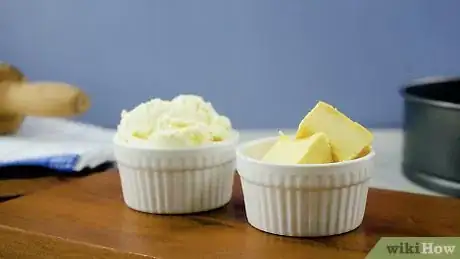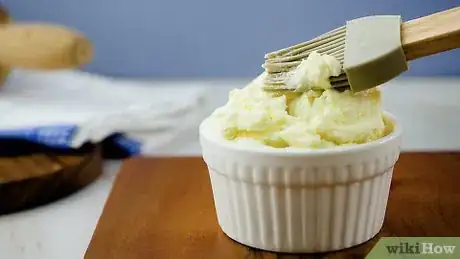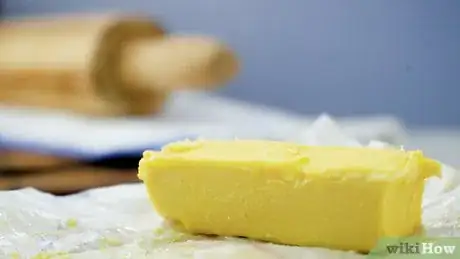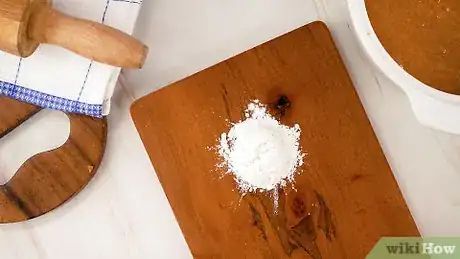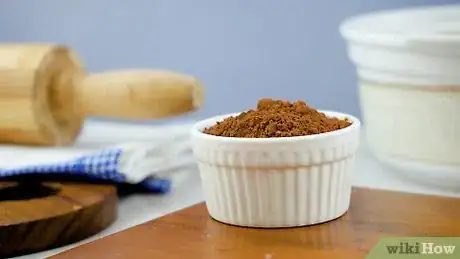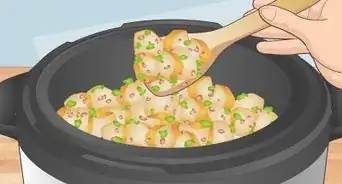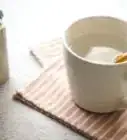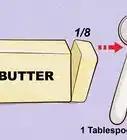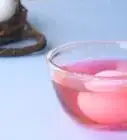This article was co-authored by wikiHow staff writer, Hannah Madden. Hannah Madden is a writer, editor, and artist currently living in Portland, Oregon. In 2018, she graduated from Portland State University with a B.S. in Environmental Studies. Hannah enjoys writing articles about conservation, sustainability, and eco-friendly products. When she isn’t writing, you can find Hannah working on hand embroidery projects and listening to music.
The wikiHow Video Team also followed the article's instructions and verified that they work.
This article has been viewed 336,179 times.
Learn more...
Many recipes for baked goods call for the pan to be greased and floured prior to adding the batter and baking. This is an important step in the baking process to ensure that the finished product doesn't stick to the sides of the pan. By greasing and flouring the pan you're creating 2 layers of non-stick protection. To do this, all you'll need to do is choose your greasing agent, decide between flour or cocoa powder, and make sure to cover every crevice of your baking pan.
Steps
Greasing Your Pan
-
1Choose between butter or shortening to grease your pan with. Butter and shortening are the 2 most common fats used to grease baking pans. Butter will impart a slight richness to the batter and will help the exterior bake to a golden brown. Shortening is flavorless and the batter is less likely to brown.[1]
- Oil-based sprays and vegetable oil should not be used to grease the pan. Oil turns into a hard glaze when it is heated that can be tough to remove from the pan.
-
2Scoop up shortening with a pastry brush for a flavorless option. Gently dip your brush or paper towel into your shortening and pick up a glob about the size of a dollar coin. If your shortening is too hard, let it sit out at room temperature until it softens up enough to be pliable.[2]
- Leave your shortening within reach in case you need more for another pan.
- You can buy pastry brushes at most home goods stores.
Advertisement -
3Open up a stick of unsalted butter for a smoother and richer pan lining. Grab a new stick of unsalted butter from the package. Open up 1 side of the paper until about half of the butter stick is out. Leave the paper on the bottom half of the butter so you can hold it without getting your hands greasy.[3]
Tip: If you are using butter from a tub, let it sit out at room temperature until it is soft and then use a pastry brush or paper towel to scoop some up.
-
4Rub butter or shortening over the bottom and sides of your pan. Spread a thin layer of your greasing agent onto the entire bottom of your pan. Make sure there are no holes in your layer. Go over every part of the pan at least once. Turn your pan on its side and apply your greasing agent to the sides of the pan as well.[4]
-
5Spray a thin layer of cooking spray on your pan if you are not baking. For normal stovetop pans and dishes, oil and cooking sprays are fine to use. Hold the spray can at least 5 inches (13 cm) away from your pan. Spray a thin layer of spray over the whole pan, making sure to coat the entire thing.[5]
- A recipe will not usually ask you to flour your pan for stovetop cooking.
Adding Flour and Batter
-
1Set aside some flour that is already used in your recipe. Various flour types can be used to flour the pan, but the rule of thumb is to use the flour that the recipe called for. This way you won't be altering the taste or composition of the batter.[6]
-
2Choose cocoa powder instead of flour for chocolate baked goods. Flour is tasteless, but it can leave a white residue on baked goods, especially if they are chocolate ones. For chocolate cakes, muffins, or any baked good that has cocoa powder in it, set aside some cocoa powder in place of flour.[7]
Tip: Cocoa powder will also add a hint of flavor to the outside of your baked good.
-
3Sprinkle flour or cocoa powder onto the pan. Add 1 or 2 tbsp. (15 to 30 ml) of flour or cocoa powder to the greased pan by pinching it in between your fingers and sprinkling it all over. Pick the pan up and tilt it about, allowing the flour to distribute and cover the entire interior of the pan. Invert the pan over the garbage or a sink and tap it gently with your hand to remove any excess flour.[8]
- The flour or cocoa powder will stick to the greasing agent that you’ve already put down.
- Flour and cocoa powder both act as a second barrier between your baked good and the pan.
- If your recipe calls for parchment paper in addition to greasing and flouring, put the parchment paper down on top of the grease and the flour or cocoa powder. It will act as another barrier between your baked good and the pan.
-
4Pour your batter into the pan. Hold your bowl of batter directly over the pan. Gently pour it in, using a spoon if you need to scrape the bowl. The flour and grease will provide a non-stick layer so that your baked good does not stick to your pan. Bake your batter according to the recipe.[9]
- Greasing and flouring your pan works better than using a non-stick oil spray.
Community Q&A
Did you know you can get answers researched by wikiHow Staff?
Unlock staff-researched answers by supporting wikiHow
-
QuestionCan I use powdered milk instead of flour?
 wikiHow Staff EditorThis answer was written by one of our trained team of researchers who validated it for accuracy and comprehensiveness.
wikiHow Staff EditorThis answer was written by one of our trained team of researchers who validated it for accuracy and comprehensiveness.
Staff Answer wikiHow Staff EditorStaff Answer
wikiHow Staff EditorStaff Answer -
QuestionIf a recipe calls for grease and parchment paper or wax paper, which goes in the pan first?
 wikiHow Staff EditorThis answer was written by one of our trained team of researchers who validated it for accuracy and comprehensiveness.
wikiHow Staff EditorThis answer was written by one of our trained team of researchers who validated it for accuracy and comprehensiveness.
Staff Answer wikiHow Staff EditorStaff Answer
wikiHow Staff EditorStaff Answer -
QuestionI'm making zucchini bread. Do I grease and flour the sides of the loaf pan as well as the bottom?
 QamarTop AnswererYes. If you'd like to slice and make the bread easier to remove, you can grease and flour the loaf pan.
QamarTop AnswererYes. If you'd like to slice and make the bread easier to remove, you can grease and flour the loaf pan.
References
- ↑ https://www.thekitchn.com/the-science-behind-greasing-and-flouring-cake-pans-before-baking-221900
- ↑ https://www.bhg.com/recipes/desserts/cakes/how-to-keep-cake-from-sticking-to-the-pan/
- ↑ https://spoonuniversity.com/lifestyle/grease-a-baking-pan-without-non-stick-spray
- ↑ https://www.bhg.com/recipes/desserts/cakes/how-to-keep-cake-from-sticking-to-the-pan/
- ↑ https://www.thekitchn.com/the-best-way-to-use-cooking-spray-without-making-a-mess-tips-from-the-kitchn-203877
- ↑ https://www.bhg.com/recipes/desserts/cakes/how-to-keep-cake-from-sticking-to-the-pan/
- ↑ https://www.bhg.com/recipes/desserts/cakes/how-to-keep-cake-from-sticking-to-the-pan/
- ↑ https://www.allrecipes.com/video/142/how-to-prep-cake-pans/
- ↑ http://cooklikeyourgrandmother.com/how-to-flour-pan/
About This Article
To grease and flour a pan, choose an agent for greasing, such as butter or shortening, and cut a piece of wax paper large enough to hold about 1 tablespoon of the grease. Hold the wax paper in your hand with the grease facing up, and then spread the fat over the interior of the pan, making sure all of the surfaces are covered. Next, dust the pan with 1-2 tablespoons of flour or cocoa powder, tilting the pan to ensure that the flour coats every part of the pan where there's grease. For tips on choosing a fat and a type of flour, read on!
